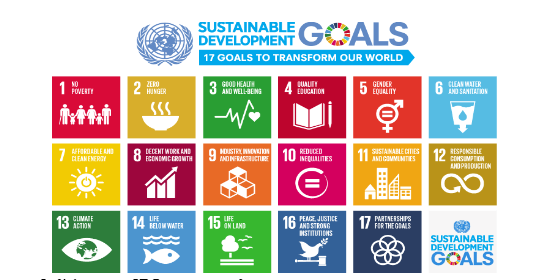
In Context
- The Prime Minister recently addressed the first meeting of Finance Ministers and Central Bank Governors under India’s G20 Presidency.
- He expressed concern that “progress on Sustainable Development Goals (SDG) seems to be slowing down”.
What is sustainable development?
- The United Nations defines sustainable development as “development that meets the needs of the present without compromising the ability of future generations to meet their own needs”.
- It includes “harmonising” three elements: economic growth, social inclusion and environmental protection.
Sustainable Development Goals
- The United Nations Document “Transforming Our World: The 2030 Agenda for Sustainable Development”.
- This agenda contains 17 goals and 169 targets.
- The agenda is built on the Millennium Development Goals (MDGs), which were adopted in 2000 and were to be achieved by 2015.
- SDGs provide a shared blueprint for peace and prosperity for people and the planet, now and into the future.
- They recognize that ending poverty and other deprivations must go hand-in-hand with strategies that improve health and education, reduce inequality, and spur economic growth – all while tackling climate change and working to preserve our oceans and forests.

India’s current SDG progress card
- About:
- A recent study assesses India’s progress on 33 welfare indicators, covering nine SDGs and providing a mixed picture of positive and concerning trends.
- Improvements:
- India is ‘On-Target’ to meeting 14 of the 33 SDGs, including indicators for
- Neonatal and under-five mortality,
- Full vaccination, improved sanitation, and
- Electricity access,
- All of which have substantially improved in the last five years.
- Skewed nature:
- Unfortunately, the national ‘On-Target’ designation does not apply equally across all districts.
- While neonatal and under-five mortality are currently both ‘On-Target’ for the country, 286 and 208 districts (out of 707 districts), respectively, are not.
- Similarly, significant progress on access to improved sanitation excludes 129 districts that are not on course to meet this SDG indicator.
- Following Indicators have improved across a vast majority of the districts between the years 2016 and 2021. They are:
- Eliminating adolescent pregnancy,
- Reducing multidimensional poverty, and
- Women having bank accounts.
- India is ‘On-Target’ to meeting 14 of the 33 SDGs, including indicators for
- Concerns:
- Of concern, for 19 of the 33 SDG indicators, the current pace of improvement is not enough to meet SDG targets.
- Despite a national policy push for clean fuel for cooking, more than two-thirds (479) of districts remain ‘Off-Target’.
- Similarly, some 415 and 278 districts are ‘Off-Target’ for improved water and handwashing facilities, respectively.
- Heightened concern:
- Of heightened concern are:
- SDG indicators for women’s well-being and
- Gender inequality.
- Girl child marriage:
- No district in India has yet succeeded in eliminating the practice of girl child marriage before the legal age of 18 years.
- At the current pace, more than three-fourths (539) of districts will not be able to reduce the prevalence of girl child marriage to the SDG target of 0.5% by 2030.
- No district in India has yet succeeded in eliminating the practice of girl child marriage before the legal age of 18 years.
- Teenage pregnancy:
- Unsurprisingly, other critical and related indicators such as teenage pregnancy (15-19 years) and partner violence (physical and sexual) that may be tracked back to child marriage are issues that India needs to escalate as priorities.
- Mobile phone access for women:
- Despite the overall expansion of mobile phone access in India (93% of households), only 56% women report owning a mobile phone, with 567 districts remaining ‘Off-Target’.
- Of heightened concern are:
Strategy to apply
- Need of policy response:
- Designing and implementing a policy response to a pressing issue is best viewed as an “optimisation problem” relying on political will, responsive administration, adequate resources, and sound data.
- Mission oriented outlook:
- Strong and sustained political leadership supported by a responsive administrative structure at all levels, from national to the district level, is critical for the success.
- Creating a mission-oriented ethos that is assessment-oriented and which provides adequate support for accomplishing India’s district-level SDGs is now urgently needed.
- Learning from COVID strategy:
- India’s lessons from ‘dealing with COVID’ strategy that can inform and optimise India’s approach to its SDG targets.
- Integrated digital platform:
- India’s success with COVID-19 was largely possible both because of the existing digital infrastructure, as well as new, indigenous initiatives such as the Co-WIN data platform, and the Aarogya Setu application.
- Following these examples, India must put in place a coordinated, public data platform for population health management, by consolidating its many siloed platforms into an integrated digital resource for district administrators, as well as State and national policy makers.
- Relief packages:
- A targeted SDG strategy delivered at scale must be executed with the same timeliness of India’s COVID-19 relief package.
Way ahead
- India needs to innovate a new policy path in order to meet the aspirations of its people in the decade ahead — there is no historical precedent for a democratic and economically open nation on how to deliver development to a billion-plus people in a manner that is healthy and sustainable.
- In successfully delivering a real-time response to the COVID-19 pandemic, India has proved that it is possible to deliver at scale in such an ambitious and comprehensive manner.
- To succeed in meeting its SDG targets, especially those related to population health and well-being, basic quality infrastructure, and gender equality, a similar concerted, pioneering, nation-wide effort would be the need of the hour.
|
Daily Mains Question
[Q] India’s lessons from ‘COVID strategy’ can inform and optimise India’s approach to its SDG targets. Analyze. |
Previous article
Governor’s Power to Assent Bills
Next article
The women’s reservation Bill cannot wait any longer